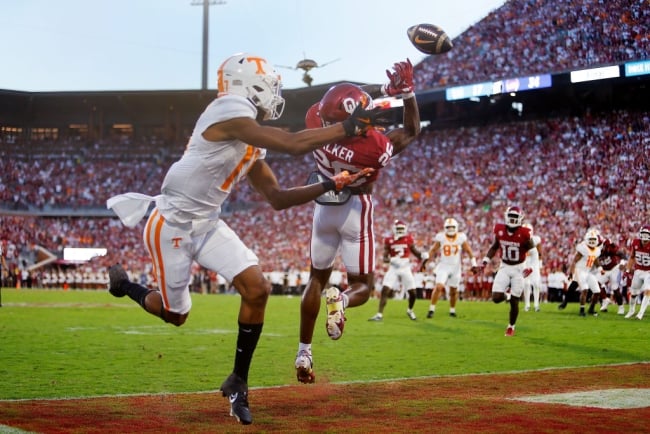You have /5 articles left.
Sign up for a free account or log in.

The University of Tennessee (in orange) and the University of Oklahoma (in red) are among the colleges that could join a proposed super league thanks to their affiliation with the Southeastern Conference.
Brian Bahr/Getty Images
The continuing turmoil in big-time college athletics—driven by the decline of amateurism and players’ success in winning the right to be compensated, virtually nonstop conference realignment that has blown up traditional rivalries in the chase for big television payouts, and doubts about the National Collegiate Athletic Association’s viability—could ultimately lead in many directions.
More intervention from Congress. Athletes who are paid directly by colleges and possibly even treated as employees. Ever-greater separation of the haves from the have-nots.
Which of these come to pass is far from certain, but the latter is likeliest. And a news report from Yahoo Sports on Tuesday suggests that one possible scenario is gaining steam: the creation of a 70-team “super league” that would incorporate football programs from the four existing “power conferences” (the Atlantic Coast, Big Ten, Big 12 and Southeastern) under a common umbrella.
The new league, pitched by a private equity firm made up of former Disney executives, would be fueled by private capital and distance itself more fully from the other 60-some colleges that compete in the Football Bowl Subdivision, in ways that could be politically contentious and further disrupt existing relationships between their universities.
The Yahoo Sports article, which is based on interviews with dozens of college sports officials, comes as representatives of the 36 universities in the Big Ten and Southeastern Conferences are prepared to meet this week in Nashville, Tenn., to discuss how the two leagues might cooperate. The two conferences, which dominate the top tier of college football, are certain to be at the center of any effort to refashion big-time athletics.
The Yahoo Sports article describes the Big Ten–Southeastern meeting as having been driven in part by the emergence of the super league idea, which it says is nicknamed “Project Rudy,” after the popular 1993 sports movie Rudy.
Yahoo Sports says the idea, reportedly pitched by Smash Capital, a private equity firm, is designed to significantly increase the value of the media revenues available to its 70 would-be member universities by consolidating their negotiating power and having them compete only against one another, eliminating the games most of them play against the other teams in the Football Bowl Subdivision and the Football Championship Subdivision.
That restriction would drive up the television value of those games—and could drive a significantly larger wedge between the universities with teams in the super league and scores of other institutions that play basketball and other sports in the NCAA’s Division I.
According to the Yahoo Sports article, more than two dozen athletics directors and conference officials have heard presentations from the project’s representatives, who reportedly include Jack Swarbrick, the former University of Notre Dame athletics director who formerly sat on the NCAA’s college football playoff committee.
The article includes many details from the PowerPoint presentation that Project Rudy officials have made, including that they would infuse “$5.3 billion in private capital—borrowed from future media revenues … to provide schools immediate cash during a three-year transition period, helping them buy out non-power opponents and supplementing their annual television distribution.”
The Yahoo article notes that the super league arrangement is designed to increase the television revenues available to participating institutions by $25 million over 12 years—roughly the amount that big-time sports–playing universities are expected to have to pay to athletes annually to satisfy the terms of the name, image and likeness settlement preliminarily approved by a federal judge Monday.
Project Rudy isn’t the only super conference being discussed. A group called College Sports Tomorrow reportedly floated a roughly similar idea last spring, and articles in The Wall Street Journal last week and a Chronicle of Higher Education op-ed by two university leaders, West Virginia University’s E. Gordon Gee and Syracuse University’s Kent Syverud, discussed that plan.
A huge number of potential impediments remain to a potential super league, including the need for congressional legislation to overcome possible antitrust problems with joint negotiation of TV rights, and the Big Ten and Southeastern Conferences being willing to give up some of their current advantages over their peers.
But the status quo is untenable for the long term, which is why conversations like this are heating up.





